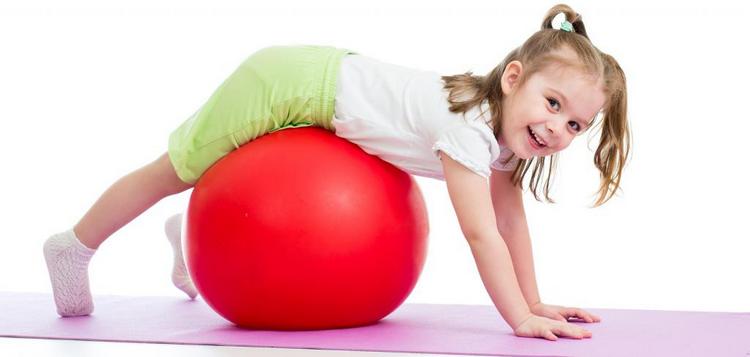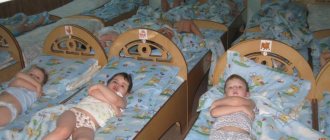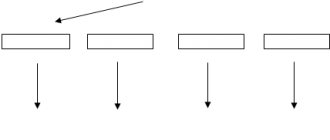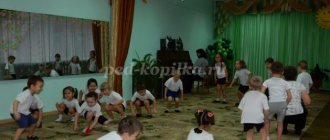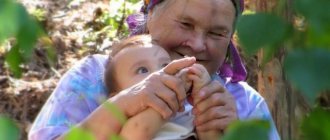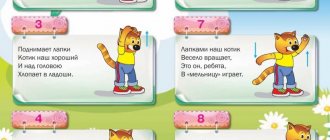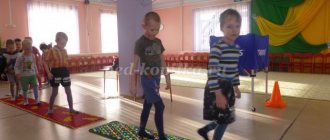Exercises in kindergarten as part of the general educational process
Kindergarten pupils must grow up healthy so that they develop the required skills and abilities, as well as abilities. A healthy baby is well trained, understands what the teacher wants from him, and is interested in learning new things. Exercise, which is a systematic activity in kindergarten, helps with this.
Charging at a preschool educational institution
Its goal is to preserve and strengthen the psyche and the body as a whole. The main task is to create a positive emotional mood. Morning exercises (MG) are an integral part of the physical training regime for preschool children. This is a set of special exercises for muscle tissue and joints.
Exercises for preschoolers can be carried out as part of activities that have a positive effect on the respiratory system and games for fine motor skills. UG can take place together with the hardening technique. In addition to health-saving functions, exercise in a preschool educational institution is important for the formation of mental processes, broadening one’s horizons, and communication skills.
Important! During ultrasonography, endorphin, the hormone of happiness, is actively produced. It improves mood and protects against negative thoughts.
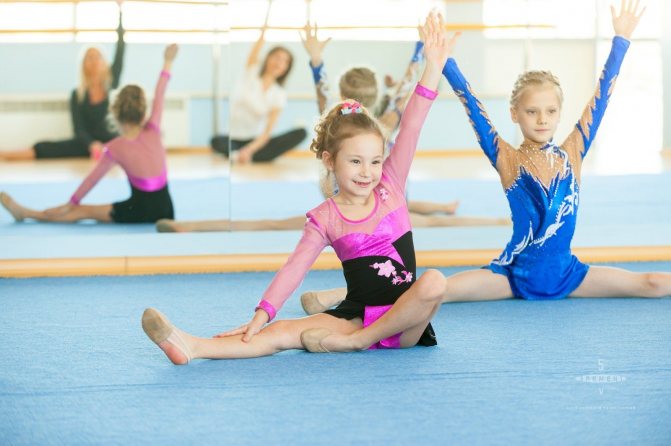
A boost of energy from performing gymnastic exercises
Goals and objectives of the UG
Gymnastics in preschool educational institutions is divided by age groups: 2-3 years, 3-4 years, 4-5 years, 5-6 years, 6-7 years. The physical component is important for the entire period of education. The purpose of exercise in kindergarten is to instill a desire to monitor your health throughout your life.
Every day the morning in kindergarten begins with a training session, which makes it possible to strengthen the little body.
For your information! It is important to instill in a person a love of physical education from childhood; in kindergarten they lay the foundation for the future. The goal of UG is to improve the functioning of body systems.
Exercise has enormous health-improving and educational significance. Many preschool teachers find it difficult to create a set of activities that will be more effective for children of different ages, and they use the recommendations of the Federal State Educational Standard.
Every morning in most kindergartens in Russia begins with UG. The purpose of exercise is to develop body muscles and improve health conditions. The baby’s body needs physical exercise, it needs to release energy. It can be directed in the most useful direction by involving preschoolers in active and interesting exercises and exciting games.
Exercise is important in organizing the day and for the well-being of the students. Those who are already awake and starting to pamper will become calmer with the help of exercises. Sleepy and inactive guys, on the contrary, will cheer up. The purpose of exercise is to normalize discipline. You should exercise daily so that your baby gets used to organized sports. Then it will not cause negative emotions and fatigue, but, on the contrary, will turn into pleasure.
For your information! It is important to choose sets of exercises according to the age and capabilities of preschoolers.
At what age to start
Up to a year, mother and baby are engaged in what can be called preparation for real gymnastics: exercises for newborns up to a month include stroking and stretching, accompanied by poetry. They give the baby a positive experience from the contact between the mother and his own body.
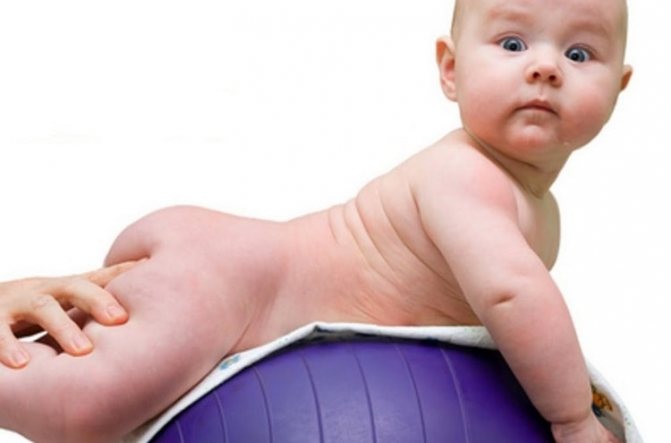
Then passive gymnastics is added to the general strengthening massage for infants: the mother carefully bends and unbends, brings and spreads the arms and legs of the baby. You can also practice with your baby on a fitball.
Important! Before doing infant gymnastics, consult your pediatrician and take a few lessons from a professional massage therapist.
Principles of gymnastic complexes
Morning exercises in kindergartens for preschool children were compiled by specialists. Complexes in children's educational institutions are carried out according to the principles:
- Accessibility: tasks and games correspond to the physical training of students, explanations and demonstrations of exercises are clear.
- Effectiveness and benefits: gymnastics develops preschoolers and improves their health.
- Positive: preschoolers do UG for a great mood; if the child is not inclined to exercise (sick, upset), he should not be forced to do the exercises.
Physical education of children in the family
For gymnastics to become a habit among preschoolers, it must interest them and evoke only positive emotions. To ensure students’ persistent motivation for classes, the teacher must choose interesting exercises, conduct them in the form of a game, or use original equipment.
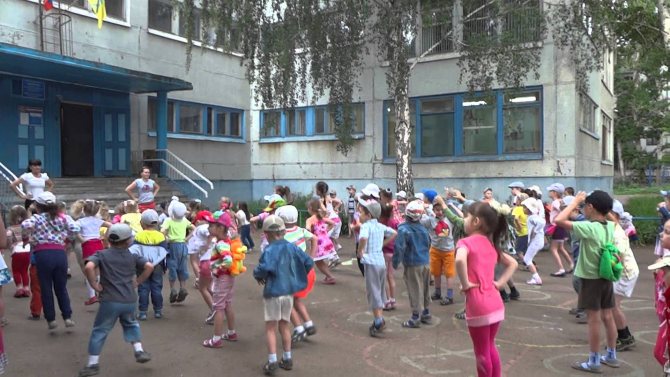
Exercise demonstration
Methods for doing exercises in kindergarten
Carrying out an educational session is a responsible process, since the work involves children. Exercises for children in preschool educational institutions should be performed either by a physical instructor in the gym, or directly by a teacher directly in the group. According to the rules, UG is carried out half an hour before the first meal.
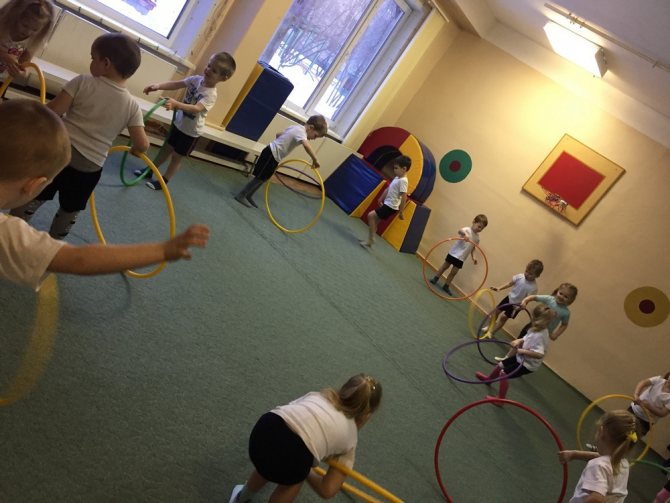
Hoop exercise
Duration recommendations
UG in each kindergarten group differs not only in duration, but also in the nature of certain exercises. Recommendations:
- The duration of the lesson in the younger group of kindergarten should not be more than 5 minutes. To make it interesting for students, exercises should take place in the form of a game with jokes and jokes. For example, kids can be asked to walk like a bear, a fox or a horse. Hula hoops, cubes and maracas are suitable for performing exercises.
- In the middle kindergarten group, the training course lasts 6 minutes. The structure of the exercise is a little more complicated than the previous one; you can add ribbons and balls as objects for exercise.
- Pupils in the senior group of kindergarten have excellent memory, so the GC can be carried out without the participation of a teacher. The teacher only has to show them how to practice once. Recommended equipment includes pigtail cords, balls, hoops and sticks. The complex can include dancing and rhythm. Lesson duration is approximately 10 minutes.
- The training session in the preparatory group of the kindergarten lasts 12 minutes and, by and large, repeats the complex of the senior group. The equipment used is jumping ropes and dumbbells. In addition, some sports elements using a wall bars can be added to the complex.
How to organize children for morning exercises
In addition to the game theme, the teacher can use other techniques to attract children to the UG. Expressive language, engaging content and positivity will help motivate students. You can play it so that they want to exercise on their own, become healthier and stronger.
An original approach will help motivate you to do morning exercises at a preschool educational institution. For example, a teacher can invite all the children to visit Winnie the Pooh, and to get there, you need to jump three times and smile. This element of the game will attract the children, and they will definitely fulfill all the conditions.
At preschool age, all children are very inquisitive. They are interested in how animals move, flowers grow and what is happening on the planet. Experienced teachers use this to organize effective exercises. They come up with a lot of playful exercises for children to exercise in the morning with the connection of characters and fictional characters.
Breathing exercises for children in the senior group of kindergarten
Important! If a child has a certificate stating that physical activity is temporarily contraindicated for him (these are issued after an illness), you can offer him to be the presenter or observe the process from the bench.
Basic rules for morning exercises for children
There are general rules that are always followed, regardless of age:
- exercises are done on an empty stomach, and to help the body wake up, you can first wash your face and drink a glass of water;
- the room should be well ventilated, it is even better to practice directly in the fresh air;
- most of the complex should consist of warm-up and stretching, and strength exercises should be avoided;
- watch your breathing: there should be no delays, there should be a rhythmic cycle of inhalation (through the nose) and exhalation (through the mouth).
- Hardening procedures (contrast shower or washing with cold water) and a healthy breakfast will help to consolidate the positive result.

In childhood, it is especially important that activities are interesting. Therefore, choose cheerful, upbeat music and change the exercises for children from time to time: add new movements, complicate them, come up with funny names for the exercises.
A set of exercises for UG
Typically, gymnastic exercises in preschool educational institutions are carried out according to a prepared plan. What a standard complex looks like:
- The lesson begins with walking in place or running in a circle. Children can walk and run in a column around the room or veranda, then in pairs or one at a time. You need to run in all directions to finish this block.
- Then the children swing their arms up and down, sideways and in a circle. This helps strengthen the shoulder muscles.
- Next, gymnastics is performed for the muscles of the lower extremities. The guys swing their legs, move them one by one to the side, lift them, bend them and stand them straight. Squats are a must.
- Why are body tilts and turns involved? These exercises are used to strengthen the back and torso.
The exercise ends with light walking in place, breathing exercises or finger games.
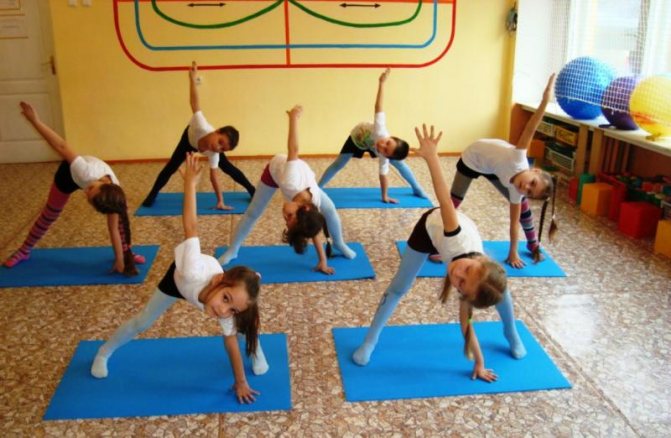
Tilting the body to the side
Warm-up
Warming up helps warm up the muscles and avoid subsequent pain. It is important to follow the correct order so that the load does not damage the children’s muscles and ligaments:
- start with fast walking;
- then load the arms, belt, back;
- the next part is strengthening the leg muscles;
- the active part includes running and jumping;
- finish with exercises to calm breathing: walking, inhaling and exhaling while raising your arms, etc.
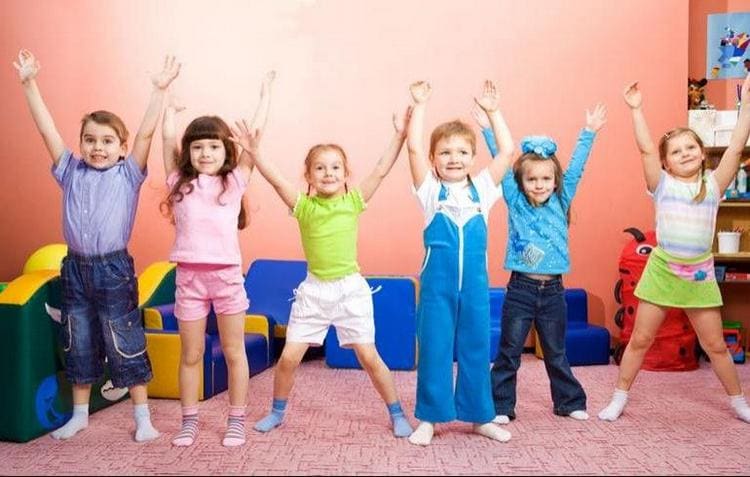
Texts for exercises in preschool educational institutions
The goal of the UG is to unite students and establish good relationships between them. The children study together, and this brings them closer together. Therefore, it is very important to do group exercises every day, thanks to which the baby will become stronger and more sociable. Rhythmic exercises are excellent to combine with entertaining poems. For this purpose, special text material has been developed. Students will enjoy practicing while listening to poetry. The texts are simple; by pronouncing them faster or slower, you can speed up the pace of your lessons or, conversely, slow them down.
Poems for gymnastics
Having learned gymnastic exercises in poetic form, children will be able to do exercises on their own without the help of a teacher, focusing on the meaning of the poem. And if adults also perform the exercise together with preschoolers, then the child is more likely to feel the significance and benefit that it can bring to everyone. In addition, poetry helps to develop.
Important! To begin with, you can try to learn the poem “Potyagushki”.
Analysis of morning exercises
Each teacher must keep a file of children, analyze and monitor classes and the condition of each child. UG analysis plan:
- age and number of preschoolers in the group;
- gymnastics venue;
- how preschoolers and the teacher are dressed;
- exercise exercises and duration;
- development tasks at each stage: what was accomplished, compliance with the stated duration;
- the effectiveness of pedagogy: display, text instructions, equipment, individual assistance;
- emotional state of preschoolers at each stage of classes;
- conclusion: whether changes or additional exercises will be required in the exercises.
For your information! Thanks to analysis and diagnostics, it is possible to summarize and improve charging, and the control chart will allow you to identify shortcomings.
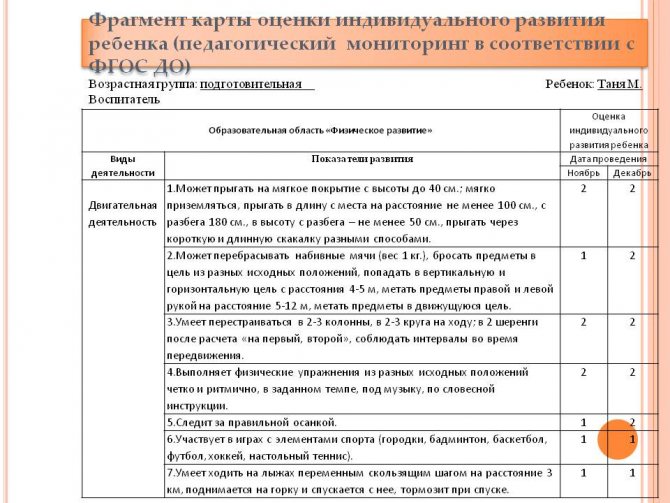
Sample of filling out a card
GC, which is carried out in a preschool institution every day, will make the baby more dexterous, energetic, help avoid a number of problems in the normal functioning of the musculoskeletal system, increase immunity, strengthen the psyche and teach interaction with other children. And by doing it in the form of a game, you can make physical exercise not only healthy, but also fun.
What to do if your muscles hurt after gymnastics
Typically, muscle pain appears as a reaction to excessive exercise. However, children's gymnastics does not involve an abundance of strength exercises, so there should be no pain in the muscles. If the load corresponds to the child’s age, but pain still appears, then perhaps the reason is the following:
- lack of water increases the likelihood of muscle spasms, so make sure that the child drinks water before exercise and that the room is not too hot;
- perhaps the problem is a lack of potassium and magnesium, so review the children's diet and add foods containing these microelements to it: beans, dried apricots, buckwheat, potatoes, spinach, pumpkin, oranges;
- muscle and joint pain may appear as a harbinger of a viral infection.
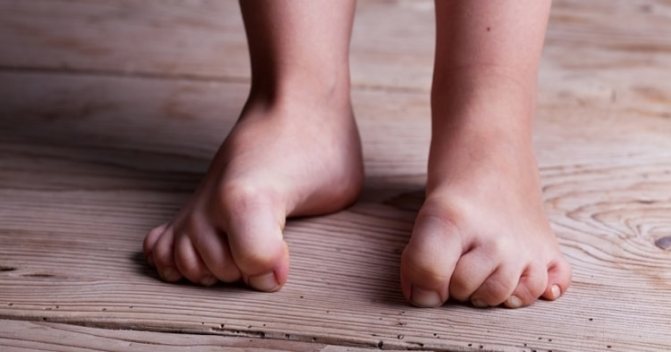
There is no need to stop exercising, as physical exercise speeds up metabolism and improves muscle condition. You just need to reduce the intensity of the load. A massage and a warm shower will help relieve excess muscle tension.
Important! The cause of pain can be not just overexertion, but muscle rupture. Then any movement in this area will cause acute pain. If this happens, you should definitely consult a doctor.
To ensure that charging brings only positive results, follow these simple tips:
- Remember that exercise should be regular, as muscle pain occurs if you begin to exercise intensively after prolonged inactivity.
- Pay attention to chronic illnesses and health conditions: If you have any chronic illness, discuss your planned exercise routine with your doctor. If your child is lethargic, has a sore throat, headache, or other signs of an impending infection, postpone activities until he or she has recovered.
- Don't force it. Exercises are done, among other things, to create a positive emotional background. And if on some day the little man refuses to do the exercises, then don’t push. Analyze the reasons: perhaps the movements are too difficult, perhaps the child is tired and cannot gather his strength, or he is simply tired of doing the same thing. Talk about the reasons for failure, make adjustments and try again.
- Follow the order of the exercises: light warm-up movements first, and then the main part.
